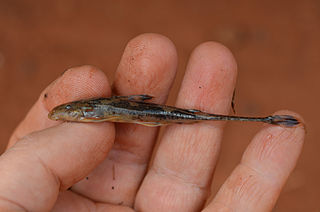Genus is a taxonomic rank used in the biological classification of living and fossil organisms as well as viruses. In the hierarchy of biological classification, genus comes above species and below family. In binomial nomenclature, the genus name forms the first part of the binomial species name for each species within the genus.

Helotiales is an order of the class Leotiomycetes within the division Ascomycota. The taxonomy within Helotiales has been debated. It has expanded significantly as genomic techniques for taxonomical identification have become more commonly used. As of February 2020, the order is estimated to contain 30 accepted families, 519 genera, and 6266 species.
The Guadalcanal rat is a species of rodent in the family Muridae. It was found only in the Solomon Islands. Since this species was collected between 1886 and 1888 it has not been seen again. It is possibly extinct.

The red-eared guenon, also called red-eared monkey, or russet-eared guenon is a primate species in the family Cercopithecidae. It is native to subtropical and tropical moist lowland forests in Cameroon, Equatorial Guinea and Nigeria. It is listed as Vulnerable on the IUCN Red List and is threatened by habitat loss, illegal bushmeat hunting and pet trade.

Epomophorus is a genus of bat in the family Pteropodidae. They have a distribution throughout Africa.

Doumea is a genus of loach catfishes native to Africa.
A taxonomic database is a database created to hold information on biological taxa – for example groups of organisms organized by species name or other taxonomic identifier – for efficient data management and information retrieval. Taxonomic databases are routinely used for the automated construction of biological checklists such as floras and faunas, both for print publication and online; to underpin the operation of web-based species information systems; as a part of biological collection management ; as well as providing, in some cases, the taxon management component of broader science or biology information systems. They are also a fundamental contribution to the discipline of biodiversity informatics.
Plazi is a Swiss-based international non-profit association supporting and promoting the development of persistent and openly accessible digital bio-taxonomic literature. Plazi is cofounder of the Biodiversity Literature Repository and is maintaining this digital taxonomic literature repository at Zenodo to provide access to FAIR data converted from taxonomic publications using the TreatmentBank service, enhances submitted taxonomic treatments by creating a version in the XML format Taxpub, and educates about the importance of maintaining open access to scientific discourse and data. It is a contributor to the evolving e-taxonomy in the field of Biodiversity Informatics.

The lesser Taiwanese shrew is a rare species of shrew in the Soricomorpha order.

Cross River is the main river in southeastern Nigeria and gives its name to Cross River State. It originates in Cameroon, where it takes the name of the Manyu River. Although not long by African standards its catchment has high rainfall and it becomes very wide. Over its last 80 kilometres (50 mi) to the sea it flows through swampy rainforest with numerous creeks and forms an inland delta near its confluence with the Calabar River, about 20 kilometres (12 mi) wide and 50 kilometres (31 mi) long between the cities of Oron on the west bank and Calabar, on the east bank, more than 30 kilometres (19 mi) from the open sea. The delta empties into a broad estuary which it shares with a few smaller rivers. At its mouth in the Atlantic Ocean, the estuary is 24 kilometres (15 mi) wide. The eastern side of the estuary is in the neighboring country of Cameroon.
Bebele is a Bantu language of Cameroon. It is mutually intelligible with other Beti dialects such as Ewondo and Fang.

The Didymellaceae are a family of fungi in the order Pleosporales. They have a world-wide distribution.

The drill is a primate of the family Cercopithecidae, related to baboons and even more closely to mandrills.

The Interim Register of Marine and Nonmarine Genera (IRMNG) is a taxonomic database which attempts to cover published genus names for all domains of life from 1758 in zoology up to the present, arranged in a single, internally consistent taxonomic hierarchy, for the benefit of Biodiversity Informatics initiatives plus general users of biodiversity (taxonomic) information. In addition to containing over 490,000 published genus name instances as at March 2020, the database holds over 1.7 million species names, although this component of the data is not maintained in as current or complete state as the genus-level holdings. IRMNG can be queried online for access to the latest version of the dataset and is also made available as periodic snapshots or data dumps for import/upload into other systems as desired.

Callirhytis is a genus of gall wasps in the family Cynipidae. There are more than 90 described species in Callirhytis. Wasps in this genus primarily induce wasps on oak trees in North America.
Doumea gracila is a species of catfish in the genus Doumea. It lives from Nyong to the Ntem rivers in southern Cameroon.
Doumea reidi is a species of catfish in the genus Doumea. It lives in the Mbam River in Nigeria. Its length reaches 9.3 cm.
Doumea skeltoni is a species of catfish in the genus Doumea. It lives in the Loémé and Kouilou-Niari rivers in the Republic of the Congo. Its length reaches 4.5 cm. It is named after South African ichthyologist Paul H. Skelton.
Doumea stilicauda is a species of loach catfish in the genus Doumea. It is only known to live in the So'o River, a tributary of the Nyong River, in Cameroon. Its length reaches 17.5 cm.
Amphilius brevis is a species of catfish in the genus Amphilius. It lives in the middle and upper Congo River in the Democratic Republic of the Congo. Its length reaches 8.4 cm.










